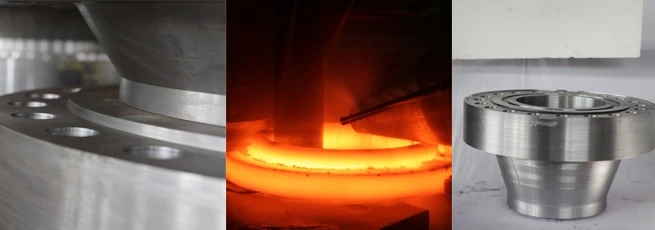The iron content in stainless steel may vary between 55% to 90%, and the chromium content may vary between the range 10% to 28%. However, stainless steel contains a minimum of 10.5% of chromium, in all cases. It is considered a special variety of steel due to the higher amount of alloy it contains and its unique and special properties compared to low-alloy and plain carbon steel. Due to chromium\'s high content, stainless steel can form a good and potent chromium oxide film on the surface and prevent iron degradation. Due to this reason, stainless steel has exceptional corrosion resistance. It offers other unique and good qualities as well, including better ductility and high strength.
Forging the Stainless Steel
A stainless steel part or product may be forged at a temperature of 1700°F to 2300°F, depending on the material\'s grade. Stainless steel can be forged to a reasonable extent with dies but may require a more significant amount of energy and loads.
Avoiding Overheating
The material has low thermal conductivity and higher flow stress. The formation of heat is much higher for stainless steel forging production than other steel varieties, including the low-alloy steel and the plain-carbon steel. It is essential to consider overheating while forging stainless steel.Overheating can cause "hot shortness" or ductile fracture,and even result in the microstructure-related issues while in service.
The stainless steel parts may also work-harden, which means they gain more strength during the deformation process. The hardening occurs during the hot forging process. Work hardening is not common with other kinds of steel and steel alloys and for carbon steel forging. Due to this reason, a cold forging process for stainless steel will require a high forging load.
Avoiding Sensitization
Sensitization in terms of the forging of stainless steel is the greater susceptibility towards intergranular corrosion, which is not desirable. Producing the forging at a temperature greater than 1700° Fahrenheit and a rapid cooling to below the temperature 900° Fahrenheit can prevent sensitization.
Sensitivity to Strain
Certain varieties of stainless steel can be more sensitive to a strain rate than low-alloy and plain-carbon steel. The speed with which the pressure is applied also affects how the metal resists flow at higher temperatures. Therefore, a relatively slower speed may be desirable when there is some difficulty in filling up the die. In some forge shops dealing with stainless steel, the workpiece may be coated with a suitable lubricant to reduce friction. The use of quality lubricant will reduce any tendency towards sticking.
Properties of the Stainless Steel Forgings
The different varieties of stainless steel may exhibit different properties after forging.
Duplex- The duplex stainless steel contains austenite and ferrite. The forging made of this kind of steel has a high chromium amount and a low amount of nickel. This forging resists crevice and stress, corrosion, and pitting.
Austenitic-This stainless steel contains around 8% nickel and 18% chromium and comprisesaround 70% of all stainless steel in use today. The forging of this variety of steel has good heat and corrosion resistance, but cannot be hardened by heat treatment.
Ferritic-This stainless steel contains chromium content between 10.5% to 27%. These steels and their forgings are highly resistant to corrosion, but may not be as durable. The ferritic stainless steel forgings cannot be hardened by heat treatment.
Martensitic- Martensitic stainless steel is less resistant to oxidation and corrosion. It has magnetic properties due to its high carbon content. The forging provides better ductility and possesses good strength. Martensitic steel can also be hardened by providing heat treatment.
Stainless steel can resist corrosion and degradation in many different corrosive environments. Reaching out to a leading forging provider and steel company in India will ensure that quality stainless steel forgings that are reliable to operate in extremely corrosive environments are only procured.



